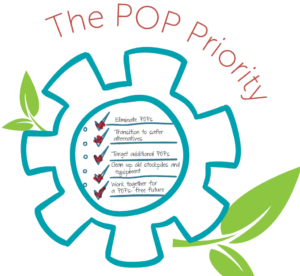Environmentally Sound Management and Disposal of Polychlorinated
An Overview of Stockholm Convention
 Stockholm Convention on Persistent Organic Pollutants (POPs) was adopted on 22nd May 2001 in Stockholm, Sweden and entered into force on 17th May 2004. The convention was ratified by Nigeria on 24th May, 2004.
Stockholm Convention on Persistent Organic Pollutants (POPs) was adopted on 22nd May 2001 in Stockholm, Sweden and entered into force on 17th May 2004. The convention was ratified by Nigeria on 24th May, 2004.
Its objective is to protect human health and the environment from POPs, mindful of the Precautionary Approach set out in Principle 15 of the Rio Declaration on Environment and Development (1992). To download Stockholm Convention Text, containing the 2019 Amendments, please, click UNEP-POPS-COP-CONVTEXT-2021.English
Persistent Organic Pollutants (POPs) are organic chemical substances, which possess a particular combination of physical and chemical properties such that, once released into the environment, they:
- remain intact for exceptionally long periods of time (many years);
- become widely distributed throughout the environment as a result of natural processes involving soil, water and, most notably, air;
- accumulate in the fatty tissue of living organisms including humans, and are found at higher concentrations at higher levels in the food chain; and
- are toxic to both humans and wildlife.
Specific effects of POPs can include cancer, allergies and hypersensitivity, damage to the central and peripheral nervous systems, reproductive disorders, and disruption of the immune system. Some POPs are also considered to be endocrine disrupters, which, by altering the hormonal system, can damage the reproductive and immune systems of exposed individuals as well as their offspring; they can also have developmental and carcinogenic effects (adapted from UN Environment, 2020). View this
Highlights of Party’s Obligations Under Stockholm Convention

Parties to Stockholm Convention are required to undertake the following obligations, are among others:-
- Prohibit and/or eliminate the production and use, as well as the import and export, of the intentionally produced POPs that are listed in Annex A to the Convention (Article 3). Annex A allows for the registration of specific exemptions for the production or use of listed POPs, in accordance with that Annex and Article 4, bearing in mind that special rules apply to PCBs. The import and export of chemicals listed in Annex A can take place under specific restrictive conditions, as set out in paragraph 2 of Article 3;
- Restrict the production and use, as well as the import and export, of the intentionally produced POPs that are listed in Annex B to the Convention (Article 3). Annex B allows for the registration of acceptable purposes for the production and use of the listed POPs, in accordance with that Annex, and for the registration of specific exemptions for the production and use of the listed POPs, in accordance with that Annex and Article 4. The import and export of chemicals listed in Annex B can take place under specific restrictive conditions, as set out in paragraph 2 of Article 3;
- Reduce or eliminate releases from unintentionally produced POPs that are listed in Annex C to the Convention (Article 5)
The Convention promotes the use of best available techniques and best environmental practices for preventing releases of POPs into the environment; - Ensure that stockpiles and wastes consisting of, containing or contaminated with POPs are managed safely and in an environmentally sound manner (Article 6). The Convention requires that such stockpiles and wastes be identified and managed to reduce or eliminate POPs releases from these sources. The Convention also requires that wastes containing POPs are transported across international boundaries taking into account relevant international rules, standards and guidelines;
- Target additional POPs (Article 8). The Convention provides for detailed procedures for the listing of new POPs in Annexes A, B and/or C (see the updated list of POPs). A Committee composed of experts in chemical assessment or management – the Persistent Organic Pollutants review Committee, is established to examine proposals for the listing of chemicals, in accordance with the process set out in Article 8 and the information requirements specified in Annexes D, E and F of the Convention;
- Develop, use and review an Implementation Plan (Article 7);
- Facilitate or undertake the exchange of information relevant to POPs (Article 9);
- Provide information and develop education and training programmes for policy makers and the public about POPs(Article 10);
- Encourage and/or undertake appropriate research, development, monitoring and cooperation pertaining to POPs and their alternatives (Article 11);
- Provide financial support and incentives for national activities under the Convention (Article 13);
- Report to the Conference of the Parties (COP) on the measures taken by the Party to implement the Convention, effectiveness of the measure taken, data on production/export/import of the POP chemicals (Article 15).
Factsheets about Polychlorinated biphenyls
Polychlorinated biphenyls (PCBs) are a class of aromatic chemical compounds, in which some or all hydrogen atoms attached to the biphenyl ring are substituted by chlorine atoms.
PCBs, as a group, was discovered in the late 1800s, became prevalent in the late 1920s as its technical benefits were recognised and developed, as well as globally produced commercially from 1930s to 1980s.
The general chemical formula is C12H10-nCln, in which “n” is the number of hydrogen substituted with chlorine. 1 to all 10 of the hydrogen atoms can be replaced with chlorines.
PCBs can be categorized based on degrees of chlorination in 10 homologue groups, ranging from monochlorobiphenyls to decachlorobiphenyls. More than 60% of the PCBs are tetra- to hexachlorophenyls.
PCBs are mixtures of individual isomers in which the chlorine content is between 21 and 68%. In theory there are 209 PCB congeners, although only about 130 have been found in commercial PCB formulations (Holoubek, 2000). PCB formulations are therefore ‘cocktails of congeners’, processed based on the manufacturers’ ‘recipes’.
PCBs donot react with both acids and alkalis and are relatively heat-stable, oil-miscible, water-immiscible, have high boiling point, low flammability and good insulating properties. Apart from their high toxicity to humans and the environment, PCBs, therefore largely possess characteristics of a good additive in products, as well as an excellent dielectric material; namely: thermal stability, chemical stability, poor electrical conductivity, cost-effectiveness, availability.
Their most reported uses are as coolants and lubricants in electrical equipment, such as transformers, capacitors and switchgears, among others. They have also been used as additives in products like hydraulic oil, carbon less paper, sealants and adhesives.
In spite of their beneficial uses’, over the last century, PCBs have been found to be detrimental to the environment and public health, due to their toxicity, persistence and tendency to bioaccumulate, biomagnify and be transported globally, typical of Persistent Organic Pollutants (POPs).
PCBs as a group was listed as one of the ‘dirty dozen’ by the Conference of the Parties to the Stockholm Convention on Persistent Organic Pollutants (POPs), which was adopted in 2001 and became effective in 2004. Nigeria is a Party to the Convention.
The convention bans the production and new uses of PCBs and requires Parties to eliminate the use of PCBs in equipment by 2025 and ensure the environmentally sound management of liquids containing PCBs and equipment contaminated with PCBs by 2028.
Registered trade names for some commercial brands of PCBs are: Aroclor, Chlorinol, Askarel, Dykanol, Pyranol (USA), Pyralene (France), Clophen (Germany), Kannechlor (Japan), Delor (Czechoslovakia), Sovol, Trichlorobiphenyls, Sovtol (USSR). View this
To download the PCBs Information Note produced by the Project Management Unit, please, click >> PCBs_Prjt_NIgeria_ICE.072021,

National Implementation Plan for Stockholm Convention
Nigeria is committed to meeting her obligations under the Stockholm Convention (SC), to safeguard the public health and the environment, by eliminating POPs use and production, minimizing POPs-releases and soundly managing POPs waste, stockpiles and contaminated sites. In demonstration of this thrust, she developed her first National Implementation Plan (NIP) in 2009, which was transmitted to the Conference of the Parties (COPs) to the Convention, in line with Article 7 thereof. The first NIP laid the groundwork for instituting and implementing administrative, institutional and policy measures targeted at addressing POPs-issues of national priority, in a systematic and participatory manner.
Following amendments to Annexes A, B and C to the Convention, via addition of new POPs by the COPs in 2009, 2011 and 2013 and in line with Article 7((1)C) and Decision SC-2/7, Nigeria approached and accessed the Global Environment Facility (GEF) support for the NIP Review and Update, which was completed and transmitted to COP in 2016. The updated NIP has documented legacy and emerging POPs issues of national priorities and integrated action plans and management strategies for tackling same.
The NIP identified, among others, eliminating PCBs through continued improvement of PCBs inventory, gradual withdrawal of PCBs-containing equipment and final disposal of their wastes in line with best practices, as one of the strategies in implementing the Convention’s obligations.
Moreover, with amendments of Annexes A, B and C to the Convention by decisions of SC COP7 (2015), COP8 (2017) and COP9 (2019), Nigeria is poised to review and update her NIP, with a view to identifying, assessing and addressing challenges of legacy (old) POPs, such as PCBs, ‘new POPs’ and emerging POPs. The Reviewed and Updated NIP can be downloaded by clicking the following link Reviewed.Updated.NIP.Clean.Copy.2016
PCB PILOT PHASE MAP INFO
Click link below to visit web map with PCB details in Nigeria
CONTACT INFORMATION
For more information, send us a mail on pcbesmandnigeria@gmail.com
